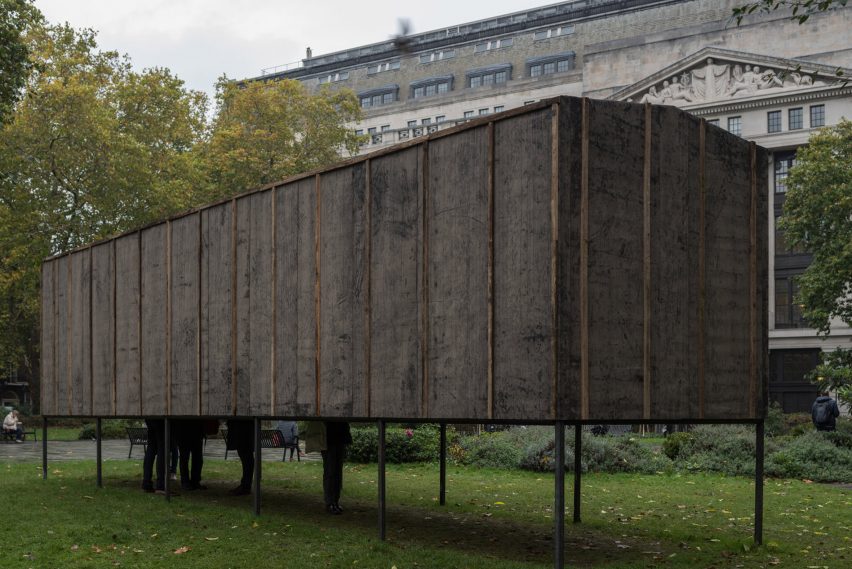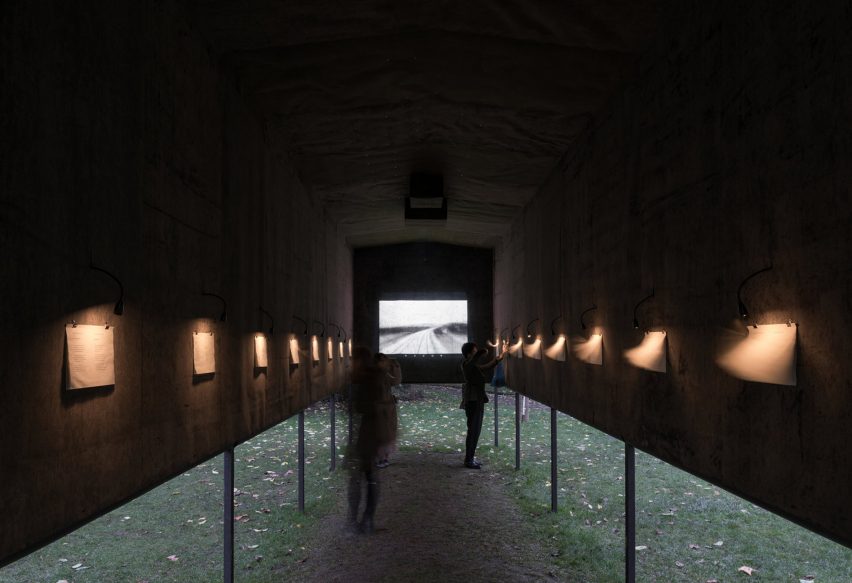
"The only living Russian architect well-known abroad is a former fantasist"
In the centenary of the Russian Revolution, Alexander Brodsky was the only national architect to offer a response. That says something about Russian architectural culture, suggests Owen Hatherley.
There was a building in London this autumn, by the last Russian architect to have any name recognition whatsoever outside that country. The architect in question is Alexander Brodsky, and the building was a pavilion called 101st km, Further Everywhere.
It was installed in Bloomsbury Square, just outside the long-established Russian cultural centre Pushkin House, who commissioned the project. It was a simple, spindly metal frame, clad in bolted-together felt. You had to clamber under the felt walls, which stopped a couple of feet before the bottom of the frame, to get in.
When you were inside, screens on each side of the walls displayed monochrome footage taken from the front of trains winding through the wastes of Siberia. On the walls, lit by little angled lamps, were printouts of poems by those who had been deported or exiled between 1917 and 1991 (with the exception of the pre-Soviet exile of Alexander Pushkin himself). In the centenary of the Russian Revolution, this was the only response by a major Russian architect. It was bleak, poetic, makeshift, and temporary.
The Soviet Union built a lot, but its architecture began and ended on paper
The Soviet Union built a lot – entire cities in Russia and Ukraine, practically entire countries in Central Asia – but its architecture began and ended on paper. Commemorative exhibitions, like the Design Museum's Imagine Moscow for instance, focused on the remarkable and unbuildable (then, for material reasons, now, for political ones) house-communes, Monuments to the Communist International and Palaces of Labour designed by the likes of Nikolai Ladovsky, Vladimir Tatlin and the Vesnin brothers in the aftermath of 1917.
But when the Soviet Union nosedived from reform to collapse in the second half of the 1980s, its best known designers abroad were the architect Alexander Brodsky – who had served his time working on standardised buildings in the state-run architectural firms – and the artist Ilya Utkin.
Their paper architecture, while equally based on a form of social fantasy, was the reverse in every way from what emerged from the revolution. It was deliberately irrational rather than coldly logical, antiquarian rather than futurist, darkly humorous rather than earnest, pessimistic and dystopian rather than optimistic and utopian, murky and gothic rather than crisp and glassy.
Brodsky and Utkin's paper work has just been republished, in the volume Cancelled 6/21/90, which features prints of plates made from zinc stolen from construction sites, which the pair made to be sold individually, and then crossed out. It's even more remarkable to look at these projects nearly three decades years on – they appear to be almost timeless.
The pair's interest in historical architecture could maybe be classed as postmodernist. The pileup of spires and domes across empty space in The Hill With a Hole shows a love of the picturesque and perverse qualities of 19th century eclecticism. The ironic and mournful Museum of Vanished Houses, which collects demolished historical buildings into an imposing, Aldo Rossi-like funereal grid, could be seen as a lament for the destruction of memory and an attack on the placelessness of modern architecture.
Brodsky commented that nothing good came out of the Russian revolution except constructivism
But Brodsky and Utkin didn't do polemic (too Soviet for them, perhaps). Their paper projects could be equally read simply as gorgeously crafted and fascinatingly illogical flights of fancy. Yet, when Brodsky came to making real, three-dimensional new space – as in the Cafe Atrium of 1989 – he first favoured an only partly parodic grotesque classicism that was ideal for the swaggering new rich, a style that has only just gone out of fashion as the house style of Moscow oligarchs. Accordingly, his usually temporary buildings of the last 10 years have tended towards rough, post-industrial and salvaged materials and oblique programmes, which is maybe closer to the gothic vision of the paper architecture.
In a public talk around the time the pavilion was opened, Brodsky commented that nothing good came out of the Russian revolution except constructivism. It's the sort of comment that helps explain why his generation of Russian liberals find themselves out of power. Those who once had free healthcare, full employment and near-free housing, and have experienced the last few decades as a plunge into terrifying poverty and uncertainty, couldn't be expected to agree with him. It also says something about capitalist Russian architectural culture that the only living architect well-known abroad is a former fantasist who only designs small pavilions.

Brodsky's anniversary pavilion seems predicated on the notion that deportation to Siberia began in 1917, when the horrible tragedy of the Russian revolution was people who had once been deported to Siberia under the Tsars meting out the same treatment to their enemies.
However, there's an uncanny power to Brodsky's response to this mostly vacuously remembered anniversary. In a grey London autumn, the wind blows the unpretentiously printed pages of Mandelstam, Shalamov, Tsvataeva et al, and the sound mingles with the rustling of the leaves. In dim November light, in the shadow of the pompously imperial Victoria House, you could almost be in Moscow, in a space that resembles either one of the gimcrack informal pavilions where people sell shawarma or socks, or a train carriage bound for somewhere appalling.
It's rare and important to make monuments to the victims of authoritarianism that are not themselves authoritarian
Inside, the texture of the building, with its untreated materials, showed an interest in surface and material rare in current architecture of any sort. It is put in the service of an unsentimental approach to history that sharply contrasts with the shrill official patriotism that has sharply increased in Russia in recent years.
In that, it's reminiscent of the public memorial project Last Address, where Brodsky has been the designer of a series of plaques placed onto the onetime homes of victims of Stalinist terror. There are many monuments to the victims of Stalinism, and often they're as pompous and nationalistic as the regime they're apparently opposing. Brodsky's plaques are matter of fact and hard, simple letters on a metal panel, with a hole in each where the photo on an ID card or passport might be. Brodsky's apparent belief that revolution only leads to terror is one that is encouraged by the current Russian government, but his memorial work belies that.
It's rare and important to make monuments to the victims of authoritarianism that are not themselves authoritarian.